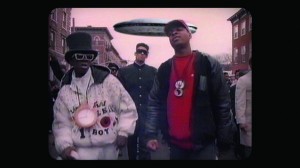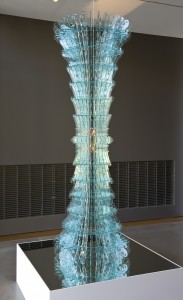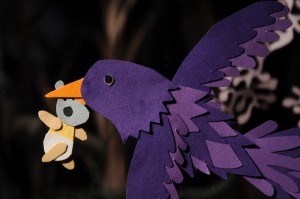On a return visit to the Gallery of Modern Art, Sharne Wolff felt the uncanny presence of a bourgeois robot…
Amongst all of the hoopla that is the ‘big V’ (Valentino) exhibition downstairs, it is easy to miss a couple of smaller but interesting exhibitions hidden away on the upper levels on the Gallery of Modern Art in Brisbane. One of those exhibitions allows the GOMA to show off its purpose-built media gallery and includes a group of seven works from all over Australia that comprise the short list in the Premier of Queensland’s National New Media Art Award 2010 The artists featured in the exhibition are Philip Brophy, Nigel Helyer, Chris Howlett, Isobel Knowles & Van Sowerwine, Soda_Jerk, Wade Marynowsky and Lynette Wallworth.
Post production with Sam Smith / HDVD file, 4-channel video projection exhibited from hard drive, 16:9, colour, sound, 25:24 mins, edition of 10. Courtesy the artists
‘New media’ in this sense comprises an engaging array of media – video, gaming, robotics, digital animation and audio electronics are all on display. Many works feature more than one medium and some are also interactive. This is the second time the biennial prize has been awarded – the first was won by Peter Alwast for his work ‘Everything’ in 2008. This is a very generous prize. It comprises a $75,000 acquisitive prize for the winning artist and a $25,000 scholarship for an emerging Queensland media artist. Entry is apparently by invitation only.
Laser cut acrylic, audio electronics
Installation at the 2010 Premier of Queensland’s National New Media Art Award exhibition
Courtesy the artist.
As one nears the gallery space the delicate glassy works of Dr Nigel Helyer (aka Dr Sonique) entitled ‘VoxÆther 01-04’ hang from the ceiling like chandeliers. They float like creatures from another world basking in the sunlight from the gallery windows and provide an inviting entrance to a darker world beyond.
Custom animation bench: Duncan Jack; Programming: Touch My Pixel; Sound: James Cecil / Interactive installation: live-feed webcam and singlechannel video constructed from stop-motion animation exhibited as Shockwave Flash from hard drive, wood, 16:9, colour, sound, ed. 1/3 / An Experimenta commission / Courtesy the artists.
The dual winners of the major prize, Isobel Knowles & Van Sowerwine, have created a work entitled You Were In My Dream (apparently based on Maurice Sendak’s classic children’s title ‘Where the Wild Things Are’) which explores ideas of childhood innocence and naivety although, at least to my mind, is seemingly more colourful and much less dark than the original story book. Interestingly, the work has been characterised as ‘tactile’ despite the fact that it is primarily a video work described by the artists on their website as “an interactive stop-motion animation shown on screens inside a physical structure with a dense, immersive soundtrack. The artists have allowed the viewer to become part of the work itself by means of a live video feed taken of the viewer’s face.
Exploring the remainder of the exhibition is done primarily in dull light because of the number of video works on show. Once inside the main entrance doors, you come across a doorway covered with a sheer black curtain and lined with lace. Through the curtain it is possible to see a large black robot, although without venturing further it’s not easy to make out the detail. With no one around except a security person on the door I wonder – am I allowed to walk inside?
Eventually I discover that I’m actually invited into the darkened room – longer than it is wide – a large black-framed mirror at the far end making the room appear much longer than it actually is. Now what? Does the robot know I am in here? If he/she does know then what next?
Electrical engineer Aras Vaichas; Software designer Mr Snow; Dressmaker Sue Marynowsky
Courtesy the artist.
I spend some time alone in the room with the robot – feeling rather uncomfortable about our encounter at first, especially because of its rather daunting size and the blinking blue lights and alternate flashing spotlight on its head which sometimes appears to be aimed at me. The robot circles around me in the dark as if checking me out and then moves away disinterested. It takes some time but I relax a bit when I realise that it isn’t quite as unnerving as it first seemed. The robot moves around the room in its layers of black and gold skirts trimmed with gold flowers and gold sequins, and its French corset top, reminiscent of music halls past. Is it female, or a male in drag? It’s hard to know, although her awkward movements and very tall appearance make it seem more like the latter.
This installation entitled The Discreet Charm of the Bourgeoisie Robot 2 by Wade Marynowsky (Electrical engineer: Aras Vaichas, Software designer: Jeremy Apthorp, Costume: Sally Jackson and Sue Marynowsky) was inspired by the 1972 French film The Discreet Charm of the Bourgeoisie by Spanish born director, Luis Bunuel. The film received an academy award for best foreign film, and is the story of a group of six friends who attempt to have dinner together in various scenarios (and sometimes with the occasional guest) but are interrupted again and again by a series of somewhat surreal events and dreams, which ultimately prevent them from doing so. The ‘discreet charm’ in the film is arguably a reference to the pointless manners and charm of the bourgeois classes, and the complete indifference of the characters portrayed in the film to their surroundings – their ‘automatic’ behaviour in the face of gory murder, gunfire, police raids and so on. The film is comic, bizarre and intriguing all at once.
As for the robot the subject of the work, despite the artists description of her as a ‘decadent disco diva of doom’, I’m struggling to work out my thoughts, although I’m almost positive now that any ‘emotions’ the robot is displaying in my presence might just have something to do with those I’m projecting on to her. I’m beginning to think she’s really quite friendly although this might also have something to do with the 1972 date from the film which triggered me into thinking about the sardonic and sometimes very funny robot on Lost in Space which screened on television around that time – “Danger, Will Robinson”. The fact that the robot is programmed to behave in a particular way and presumably even to mimic some human behaviour makes her ‘safe’ and rather predictable. Perhaps the same goes for the characters in the film.
I ask a couple of others leaving the room after me to describe their feelings about the diva. One says, “She’s a bit intimidating”, although his friend assures him that there’s no problem because “he’s always been intimidated by tall women”. The others refer to her as a ‘giant chess piece’ (I’m assuming they mean the black Queen) or like something from Doctor Who.
Now that I think I’ve become a little more familiar with the robot I think I’m going to have to go back and visit the exhibition again – just to make sure I’m right about her.
Premier of Queensland’s National New Media Art Award 2010
Gallery 2.1 at the Gallery of Modern Art
28 August – 7 November 2010




